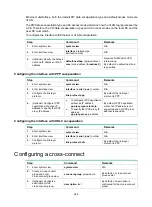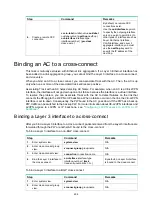
389
Configuring MPLS L2VPN
MPLS L2VPN provides point-to-point and point-to-multipoint connections. This chapter describes
only the MPLS L2VPN technologies that provide point-to-point connections. For information about
the MPLS L2VPN technologies that provide point-to-multipoint connections, see "Configuring
VPLS."
Overview
MPLS L2VPN is an implementation of Pseudo Wire Emulation Edge-to-Edge (PWE3). It offers Layer
2 VPN services over an MPLS or IP backbone. MPLS L2VPN can transparently transmit Layer 2
data for different data link layer protocols, including Ethernet, VLAN, FR, and PPP.
From a user's perspective, the MPLS or IP backbone is a Layer 2 switched network. For example,
when two Ethernet networks are connected through MPLS L2VPN over an MPLS backbone,
Ethernet users think they are connected directly through an Ethernet.
Basic concepts of MPLS L2VPN
•
Customer
edge
—A CE is a customer device directly connected to the service provider
network.
•
Provider
edge
—A PE is a service provider device connected to one or more CEs. It provides
VPN access by mapping and forwarding packets between user networks and public tunnels.
•
Attachment
circuit
—An AC is a link between a CE and a PE, such as an FR DLCI, Ethernet
interface, PPP connection, or VLAN.
•
Pseudowire
—A PW is a virtual bidirectional connection between two PEs. An MPLS PW
comprises a pair of LSPs in opposite directions.
•
Public
tunnel
—A public tunnel is a connection that carries one or more PWs across the MPLS
or IP backbone. It can be an LSP tunnel, an MPLS TE tunnel, or a GRE tunnel.
•
Cross-connect
—A cross-connect connects two physical or virtual circuits such as ACs and
PWs. It switches packets between the two physical or virtual circuits. Cross-connects include
AC to AC cross-connect, AC to PW cross-connect, and PW to PW cross-connect.
•
Site
ID
—A site ID uniquely identifies a site in a VPN. Sites in different VPNs can have the same
site ID.
•
Route
distinguisher
—A route distinguisher (RD) is added before a site ID to distinguish the
sites that have the same site ID but reside in different VPNs. An RD and a site ID uniquely
identify a VPN site.
•
Label
block
—A label block is a set of labels. It includes the following parameters:
{
Label base
—The LB specifies the initial label value of the label block. A PE automatically
selects an LB value that cannot be manually modified.
{
Label range
—The LR specifies the number of labels that the label block contains. The LB
and LR determine the labels contained in the label block. For example, if the LB is 1000 and
the LR is 5, the label block contains labels 1000 through 1004.
{
Label-block offset
—The LO specifies the offset of a label block. If the existing label block
becomes insufficient as the VPN sites increase, you can add a new label block to enlarge
the label range. A PE uses an LO to identify the position of the new label block. The LO
value of a label block is the sum of the LRs of all previously assigned label blocks. For
example, if the LR and LO of the first label block are 10 and 0, the LO of the second label
block is 10. If the LR of the second label block is 20, the LO of the third label block is 30.
A label block with LB, LO, and LR as 1000, 10, and 5, respectively, is represented as 1000/10/5.
















































